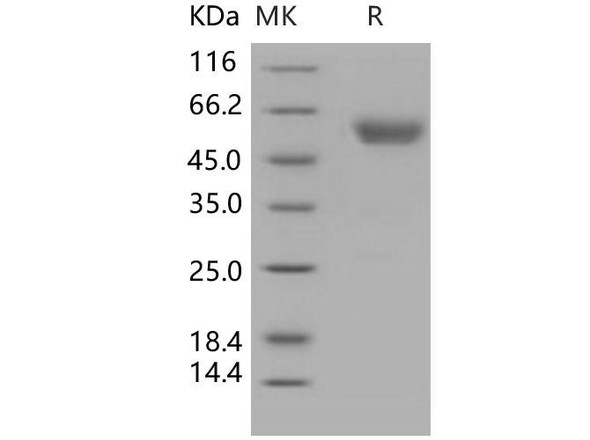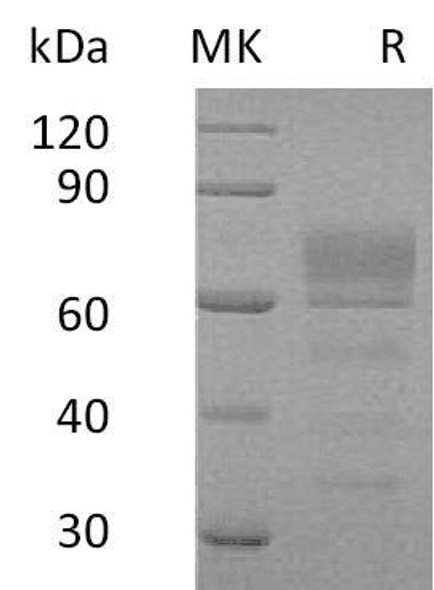Human PDPN (Podoplanin) ELISA Kit (HUES02772)
- SKU:
- HUES02772
- Product Type:
- ELISA Kit
- Size:
- 96 Assays
- Uniprot:
- Q86YL7
- Sensitivity:
- 0.09ng/mL
- Range:
- 0.16-10ng/mL
- ELISA Type:
- Sandwich
- Synonyms:
- AGGRUS, GP40, GP36, Gp38, HT1A-1, OTS8, PA2.26, T1A, T1A-2
- Reactivity:
- Human
- Sample Type:
- Serum, plasma and other biological fluids
- Research Area:
- Cell Biology
Description
Human PDPN (Podoplanin) ELISA Kit
The Human PDPN (Podoplanin) ELISA Kit is specifically designed for the precise detection of podoplanin levels in human serum, plasma, and cell culture supernatants. This kit offers exceptional sensitivity and specificity, guaranteeing trustworthy and consistent results, making it perfect for a variety of research purposes.Podoplanin is a key protein involved in cell adhesion and migration, playing a critical role in various physiological and pathological processes.
It is implicated in cancer metastasis, lymphatic vessel formation, and immune response modulation, making it a valuable biomarker for investigating these processes and developing potential treatment strategies.Order the Human PDPN (Podoplanin) ELISA Kit today to advance your research and uncover new insights into the functions and implications of podoplanin in health and disease.
| Assay type: | Sandwich |
| Format: | 96T |
| Assay time: | 4.5h |
| Reactivity: | Human |
| Detection Method: | Colormetric |
| Detection Range: | 0.16-10 ng/mL |
| Sensitivity: | 0.10 ng/mL |
| Sample Volume Required Per Well: | 100µL |
| Sample Type: | Serum, plasma and other biological fluids |
| Specificity: | This kit recognizes Human PDPN in samples. No significant cross-reactivity or interference between Human PDPN and analogues was observed. |
This ELISA kit uses Sandwich-ELISA as the method. The micro ELISA plate provided in this kit has been pre-coated with an antibody specific to Human PDPN. Standards or samples are added to the appropriate micro ELISA plate wells and combined with the specific antibody. Then a biotinylated detection antibody specific for Human PDPN and Avidin-Horseradish Peroxidase (HRP) conjugate are added to each micro plate well successively and incubated. Free components are washed away. The substrate solution is added to each well. Only those wells that contain Human PDPN, biotinylated detection antibody and Avidin-HRP conjugate will appear blue in color. The enzyme-substrate reaction is terminated by adding Stop Solution and the color turns yellow. The optical density (OD) is measured spectrophotometrically at a wavelength of 450 nm ± 2 nm. The OD value is proportional to the concentration of Human PDPN. The concentration of Human PDPN in samples can be calculated by comparing the OD of the samples to the standard curve.
| UniProt Protein Function: | PDPN: May be involved in cell migration and/or actin cytoskeleton organization. When expressed in keratinocytes, induces changes in cell morphology with transfected cells showing an elongated shape, numerous membrane protrusions, major reorganization of the actin cytoskeleton, increased motility and decreased cell adhesion. Required for normal lung cell proliferation and alveolus formation at birth. Induces platelet aggregation. Does not have any effect on folic acid or amino acid transport. Does not function as a water channel or as a regulator of aquaporin-type water channels. Belongs to the podoplanin family. 4 isoforms of the human protein are produced by alternative splicing. |
| UniProt Protein Details: | Protein type:Membrane protein, integral Chromosomal Location of Human Ortholog: 1p36. 21 Cellular Component: external side of plasma membrane; filopodium; filopodium membrane; integral to plasma membrane; lamellipodium; microvillus membrane; plasma membrane; ruffle Molecular Function:amino acid transmembrane transporter activity; folic acid transporter activity; water channel activity; water transporter activity Biological Process: alveolus development; amino acid transport; cell morphogenesis; cell motility involved in cell locomotion; cell proliferation; cell-cell adhesion; folic acid transport; lung development; lymphangiogenesis; platelet activation; positive regulation of cell motility; prostaglandin metabolic process; regulation of cell shape; signal transduction; water transport |
| NCBI Summary: | This gene encodes a type-I integral membrane glycoprotein with diverse distribution in human tissues. The physiological function of this protein may be related to its mucin-type character. The homologous protein in other species has been described as a differentiation antigen and influenza-virus receptor. The specific function of this protein has not been determined but it has been proposed as a marker of lung injury. Alternatively spliced transcript variants encoding different isoforms have been identified. [provided by RefSeq, Jul 2008] |
| UniProt Code: | Q86YL7 |
| NCBI GenInfo Identifier: | 215274223 |
| NCBI Gene ID: | 10630 |
| NCBI Accession: | Q86YL7. 3 |
| UniProt Secondary Accession: | Q86YL7,O60836, O95128, Q7L375, Q8NBQ8, Q8NBR3, A9Z1Y2 B2R6J8, E9PB68, F6QWX5, |
| UniProt Related Accession: | Q86YL7 |
| Molecular Weight: | 12,421 Da |
| NCBI Full Name: | Podoplanin |
| NCBI Synonym Full Names: | podoplanin |
| NCBI Official Symbol: | PDPN |
| NCBI Official Synonym Symbols: | T1A; GP36; GP40; Gp38; OTS8; T1A2; TI1A; T1A-2; AGGRUS; HT1A-1; PA2. 26 |
| NCBI Protein Information: | podoplanin |
| UniProt Protein Name: | Podoplanin |
| UniProt Synonym Protein Names: | Aggrus; Glycoprotein 36; Gp36; PA2. 26 antigen; T1-alpha; T1A |
| Protein Family: | Podoplanin |
| UniProt Gene Name: | PDPN |
| UniProt Entry Name: | PDPN_HUMAN |
As the OD values of the standard curve may vary according to the conditions of the actual assay performance (e. g. operator, pipetting technique, washing technique or temperature effects), the operator should establish a standard curve for each test. Typical standard curve and data is provided below for reference only.
| Concentration (ng/mL) | O.D | Average | Corrected |
| 10 | 2.194 2.196 | 2.195 | 2.138 |
| 5 | 1.405 1.407 | 1.406 | 1.349 |
| 2.5 | 0.822 0.808 | 0.815 | 0.758 |
| 1.25 | 0.383 0.417 | 0.4 | 0.343 |
| 0.63 | 0.233 0.215 | 0.224 | 0.167 |
| 0.32 | 0.155 0.139 | 0.147 | 0.09 |
| 0.16 | 0.101 0.107 | 0.104 | 0.047 |
| 0 | 0.055 0.059 | 0.057 | -- |
Precision
Intra-assay Precision (Precision within an assay): 3 samples with low, mid range and high level Human PDPN were tested 20 times on one plate, respectively.
Inter-assay Precision (Precision between assays): 3 samples with low, mid range and high level Human PDPN were tested on 3 different plates, 20 replicates in each plate.
| Intra-assay Precision | Inter-assay Precision | |||||
| Sample | 1 | 2 | 3 | 1 | 2 | 3 |
| n | 20 | 20 | 20 | 20 | 20 | 20 |
| Mean (ng/mL) | 0.54 | 1.14 | 4.86 | 0.55 | 1.21 | 4.69 |
| Standard deviation | 0.03 | 0.06 | 0.23 | 0.03 | 0.06 | 0.25 |
| C V (%) | 5.56 | 5.26 | 4.73 | 5.45 | 4.96 | 5.33 |
Recovery
The recovery of Human PDPN spiked at three different levels in samples throughout the range of the assay was evaluated in various matrices.
| Sample Type | Range (%) | Average Recovery (%) |
| Serum (n=5) | 92-109 | 99 |
| EDTA plasma (n=5) | 92-106 | 98 |
| Cell culture media (n=5) | 96-108 | 101 |
Linearity
Samples were spiked with high concentrations of Human PDPN and diluted with Reference Standard & Sample Diluent to produce samples with values within the range of the assay.
| Serum (n=5) | EDTA plasma (n=5) | Cell culture media (n=5) | ||
| 1:2 | Range (%) | 93-109 | 88-99 | 86-97 |
| Average (%) | 100 | 93 | 92 | |
| 1:4 | Range (%) | 88-104 | 83-95 | 83-95 |
| Average (%) | 95 | 87 | 88 | |
| 1:8 | Range (%) | 92-103 | 81-93 | 83-96 |
| Average (%) | 97 | 85 | 89 | |
| 1:16 | Range (%) | 86-99 | 85-96 | 87-102 |
| Average (%) | 92 | 91 | 93 |
An unopened kit can be stored at 4°C for 1 month. If the kit is not used within 1 month, store the items separately according to the following conditions once the kit is received.
| Item | Specifications | Storage |
| Micro ELISA Plate(Dismountable) | 8 wells ×12 strips | -20°C, 6 months |
| Reference Standard | 2 vials | |
| Concentrated Biotinylated Detection Ab (100×) | 1 vial, 120 µL | |
| Concentrated HRP Conjugate (100×) | 1 vial, 120 µL | -20°C(shading light), 6 months |
| Reference Standard & Sample Diluent | 1 vial, 20 mL | 4°C, 6 months |
| Biotinylated Detection Ab Diluent | 1 vial, 14 mL | |
| HRP Conjugate Diluent | 1 vial, 14 mL | |
| Concentrated Wash Buffer (25×) | 1 vial, 30 mL | |
| Substrate Reagent | 1 vial, 10 mL | 4°C(shading light) |
| Stop Solution | 1 vial, 10 mL | 4°C |
| Plate Sealer | 5 pieces | |
| Product Description | 1 copy | |
| Certificate of Analysis | 1 copy |
- Set standard, test sample and control (zero) wells on the pre-coated plate and record theirpositions. It is recommended to measure each standard and sample in duplicate. Note: addall solutions to the bottom of the plate wells while avoiding contact with the well walls. Ensuresolutions do not foam when adding to the wells.
- Aliquot 100µl of standard solutions into the standard wells.
- Add 100µl of Sample / Standard dilution buffer into the control (zero) well.
- Add 100µl of properly diluted sample (serum, plasma, tissue homogenates and otherbiological fluids) into test sample wells.
- Cover the plate with the sealer provided in the kit and incubate for 90 min at 37°C.
- Aspirate the liquid from each well, do not wash. Immediately add 100µL of BiotinylatedDetection Ab working solution to each well. Cover the plate with a plate seal and gently mix. Incubate for 1 hour at 37°C.
- Aspirate or decant the solution from the plate and add 350µL of wash buffer to each welland incubate for 1-2 minutes at room temperature. Aspirate the solution from each well andclap the plate on absorbent filter paper to dry. Repeat this process 3 times. Note: a microplatewasher can be used in this step and other wash steps.
- Add 100µL of HRP Conjugate working solution to each well. Cover with a plate seal andincubate for 30 min at 37°C.
- Aspirate or decant the solution from each well. Repeat the wash process for five times asconducted in step 7.
- Add 90µL of Substrate Reagent to each well. Cover with a new plate seal and incubate forapproximately 15 min at 37°C. Protect the plate from light. Note: the reaction time can beshortened or extended according to the actual color change, but not by more than 30min.
- Add 50 µL of Stop Solution to each well. Note: Adding the stop solution should be done inthe same order as the substrate solution.
- Determine the optical density (OD value) of each well immediately with a microplate readerset at 450 nm.










